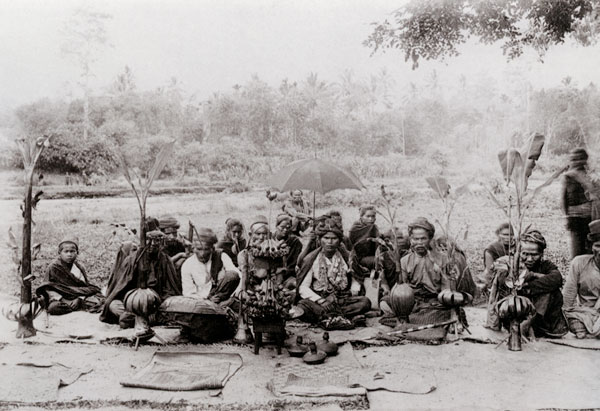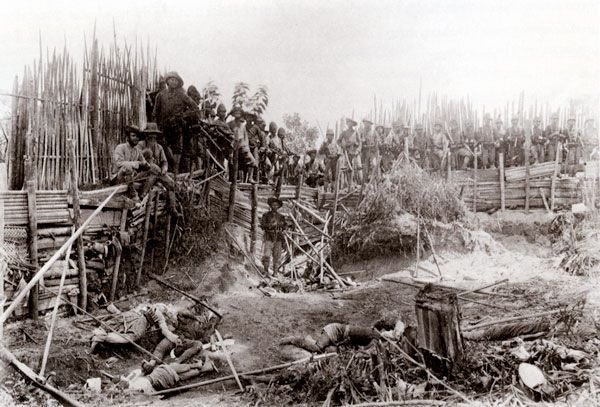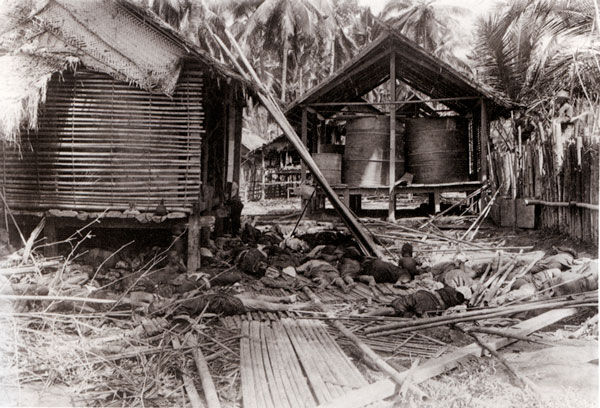 |
H. M. Neeb
Acehnese village chiefs paying their respects to Dutch colonial rulers, c.1905 |
The Aceh war was the longest war of the Dutch colonial era. For centuries, Aceh had remained independent despite Dutch and British attempts at colonial expansion in the Strait of Malacca, the narrow body of water separating Sumatra from the Malay Peninsula to the north. In 1871, the Treaty of London, an agreement by Europeans not to interfere in Aceh, was dissolved, and from 1873 to 1914 the Islamic population fought against annexation by the Dutch, who initially occupied only the town of Banda Aceh. In 1904, a military campaign led by Lieutenant Colonel G. C. E. Van Daalen completed the occupation of Aceh.
H. M. Neeb, a military doctor, photographed the events of the campaign.1 In his series of 167 pictures there is a clearly propagandistic theme that stresses the discipline and superiority of the Royal Dutch Indies Army (KNIL). Although perhaps unintended, Neeb's visual account also reveals the atrocities that resulted from the fighting. Within five months, almost 3,000 Aceh people were killed, more than 1,000 of them women and children. Roughly one-third of the region's population fell victim to the violent annexation which, only two years later, was condemned in the Dutch parliament.2
Hendticus Marinus Neeb was born in Muntok, on the island Bangka, situated off the eastern coast of Sumatra on November 22,1870. His father, also a military doctor, was P. G. Neeb. Neeb went to the Netherlands to study medicine in Leiden; he joined the KNIL in 1892, shortly after he passed his exams. The next year he returned to Indonesia and started his medical career at the military hospital of Surabaya. He was transferred several times over the next few years.
In June 1903, Neeb was sent to Banda Aceh and was appointed to join the campaign of Van Daalen, which, from February 8 to July 23,1904, took him through the regions of Gayo, Alas and Batak. Neeb was promoted during the campaign and was afterward made knight of the Militaire Willemsorde. Neeb stayed in Aceh until at least November 24,1907, when he took pictures in Sidikalang. From then on he concentrated fully on his medical career; his only known late pictures date from 1910, when he attended an international medical congress in Manila and used his camera for his research on the organization of American military hospitals there. He practiced medicine and lectured until his death on September 15, 1933; he was buried in Bandung.
It is not known how Neeb learned photography. There is perhaps a link with C. J. Neeb, another military doctor who is supposed to have been his brother and who photographed during the campaign to Lombok of 1894. The earliest known H. M. Neeb pictures are from 1904, and they show that he was already a skilled photographer. J. C. J. Kempees, the aide-de-camp to Van Daalen, mentions in his 1904 book that Neeb's photographic equipment included a portable darkroom. He probably used dry collodion glass negatives that he developed, and perhaps printed, during the campaign.
It has been assumed that Van Daalen assigned Neeb to photograph the Aceh Wars, yet none of the contemporary reports confirm this, nor do they say that Neeb was especially trained to do so. The fact remains, however, that the pictures remained in Neeb's possession after the conflict. From Kempees' writings and from the detailed captions Neeb gave to the prints, it can be concluded that Neeb worked systematically, as if he fully intended to make a complete visual report. He included topographic pictures of the areas the troops marched through, showing natural obstacles like mountains and rivers. All bivouac sites were recorded, and fortified kampungs, or villages, to be attacked were photographed during reconnoitering patrols.
It was technically impossible to take pictures of the actual attacks; but, as soon as a kampung was captured, Neeb went inside with his camera, following the sequence of the combat. He started by showing the points of attack and the fortifications and followed this with images of the indigenous victims overlooked by their conquerors. He photographed corpses from close range, with their wounds and distorted faces clearly visible. Sometimes even crying young children were still sitting or crawling amidst the victims.
It seems unlikely that Neeb's sole motive was to gather visual proof of the Dutch victories and superiority, although that is the inherent message of most of the pictures. The pictures recording the chiefs' surrender to Van Daalen would have served the same purpose, however. Propagandistic elements can be seen in his photographs of bivouacs, including those of his own field hospital, that show how well organized and disciplined the KNIL was. Neeb choose not to photograph demoralizing scenes, and military life was only shown from the heroic and cozy side. Wounded or killed KNIL soldiers were not depicted in the manner that the victims in the kampungs were; there is only a single picture of a military cemetery, one at Kuta Lintang with the troops' white dog sitting in the foreground as a symbol of loyalty.
The conquered Gayo and Alas people are depicted either as corpses killed by the Dutch or as victims expressing their obedience to Van Daalen. Their faces, however, express obstinacy and distrust.
This balance of power is also reflected in pictures that Neeb took out of anthropological interest. He photographed the wedding of Si Pi Ih, son of a Kedjuron, a sovereign lord, who was loyal to Van Daalen. Neeb asked for permission to make a portrait of the married couple, but the bride and the women accompanying her, in accordance with Islamic tradition, were reluctant to pose. The women fled, but the groom forced the bride to stay, and even to unveil her face. The man might not have exposed his wife to such embarrassment if the other relationship involved were not that of ruler versus subject.
Within this context of Dutch domination and propaganda, questions arise of why Neeb portrayed the indigenous Aceh victims in the kampungs so realistically, revealing the shocking facts of the campaign; and why he gave priority to photography instead of first taking care of the wounded and the orphans, as might be expected from a doctor. As a military doctor, he may have been accustomed to wounds, death and violence. Impassive to the distress, he may have persistently continued his photographic series whenever his medical work allowed. If, in fact, Neeb was commissioned by Van Daalen to photograph, that assignment could well have superseded his medical duties and concerns.
Neeb's Aceh War images are an early example of photography's ability to encompass contrary meaning and intention. While Van Daalen obviously did not prevent Neeb from making revealing images, he may have also been indifferent to the losses, proud of his achievements and unable to comprehend the impact the images would have later on.
Kempees wrote that the soldiers were amazed by the tenacity of the Aceh people, with both men and women fighting in festal attire, wearing ornaments and determined to fight to the death. Neeb must have been aware of the unmatched losses of the war. His general views showing the number of corpses in each captured kampungmust have been intended to depict at what costs Dutch authority had been established. With these pictures, Neeb gave witness of the courage and strength of the people's will to withstand Dutch rule.
Neeb's photographs were soon presented to the public in the Netherlands and Indonesia. Kempees published twenty-eight images in his book, and the reviews were mostly sympathetic. In 1906 Van Daalen offered the Museum of Ethnology in Rotterdam 168 Neeb images. Today, these photographs still elicit feelings of shock at the events at Aceh, just as they did in the Netherlands nearly a century ago.
NOTES
1. Primary sources for biographical and historical information on H. M. Neeb and the Aceh Wars include the following:
- Kempees, J.C.J., De tocht van overste Van Daalen door de Gajo—, Alas—en Bataklanden, Amsterdam 1904.
- Stibbe, D.G. and C. Spat (ed.), Encyclopaedie van Nederlandsch-lndie, 's-Gravenhage, 1935, suppl. Vll, t407-:408.
- Van Daalen, G.C.E., "Verslag van den tocht naar de Gajo-en Alaslanden in de maanden februari tot en met juli 1904 onder den luitenant-kolonel van den generalen staf G.C.E. van Daalen," in: Indisch Militair Tijdschrifi, Sp. Iss.no. 14 (1909).
2. "Lijst van fotogrammen, vervaardigd door...H. M. Neeb," in Notulen van bet Bataviaascb Genootsehap van Kunsten en Wetenschappen, XXLI1 (1904) Bijlage XV. 1. Veer, P. van't, De Atjeb—oorlog, Amsterdam, 1969, 267-272.
 |
H. M. Neeb
Proud Dutch soldiers with weapons drawn during the Aceh War, 1904 |
 |
H. M. Neeb
Two Dutch soldiers standing by Acehnese storage huts,
while two babies cry among dead family members, 1904 |
| next paper | about Anneke Groeneveld
| contents page | asia-pacific photography | photo-web | contacts |